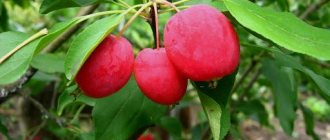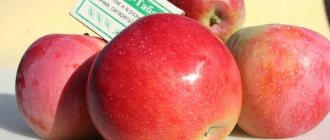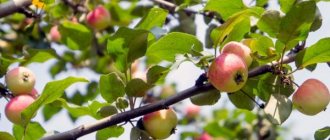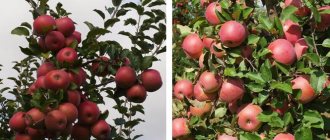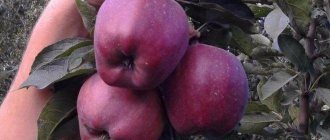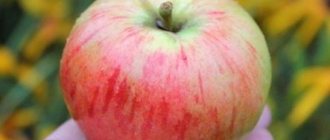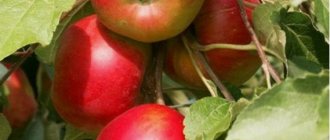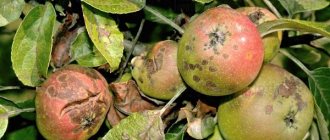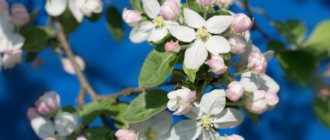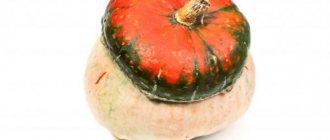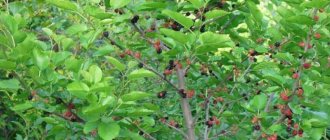Growing a wide variety of crops, which not so much bear fruit as decorate personal plots, can be considered a traditional occupation of Russian summer residents and gardeners. That is why their interest in ornamental apple trees is growing steadily. We decided to introduce readers to the main characteristics, cultivation features and the most common varieties of this group of plants.
Decorative apple trees are widely used in the landscape design of summer cottages and household plots, in urban landscaping of streets, parks and public gardens.
About the apple tree
Ornamental varieties of apple trees, like their cultivated relatives, bear fruit. However, their fruits are not always suitable for consumption. Caring for an apple tree and the subtleties of planting are slightly different, but they are not complicated. Apple tree
Tree morphology
A young apple tree is not tall, usually up to 3 meters. But its branches are very long and flexible, they are completely covered with leaves, so they bend to the ground under their weight. It is very important to carry out pruning in a timely manner so that the shape of the crown is neat. Apple trees, depending on how the crown is formed, can be grown in a composition or as a single decoration. Trees grafted on a trunk deserve special attention.
Weeping red apple tree.
Description of fruits
The fruits are very small, bright red in color. There are a lot of them, the branches seem to be completely covered with them on all sides. The fruits stick tightly to the shoots, even after the onset of frost, which will add decorativeness. The fruits taste sweetish, although not in the generally accepted sense. They can be eaten fresh and even made into jam. Gardeners often make cider from them.
Productivity
It is difficult to give an exact figure for how many fruits can be collected from one tree. Apples completely cover the branches, there are simply a huge number of them. Therefore, the exact weight of the collected fruits depends on the width and length of the crown branches. But there are really a lot of them.
Frost resistance
The Plakuchaya variety can be cultivated throughout almost the entire territory of the Russian Federation, with the exception of rare very cold regions. It is also widespread in nearby countries and throughout Europe. The dense bark with which the shoots are covered allows them to survive even severe frosts.
Description of ornamental apple trees and their fruits
Apple trees are tree-like, bushy and columnar. The shape of the tree crown is formed in accordance with the design concept. Typically, a spherical, umbrella or weeping shape is chosen. Weeping varieties are characterized by long branches descending to the ground. In the shade of such a crown it is good to place a place to rest. Columnar plants have practically no side branches.
Among the characteristic features of decorative culture, experts name the following:
- The inimitable visual appeal, beauty of flowers, leaves, fruits, compact form allow the plant to be used as a decorative element of the garden or hedge.
- Flowering usually begins in May and lasts 2 weeks.
- The small, brightly colored fruits of the crop (the size of a small apricot) are practically inedible and are also decorative. Some miniature apples are used in cooking to make jams and compotes.
- Frost resistance. The plant tolerates the harsh conditions of the northern regions well.
- Unpretentiousness to the chosen place and soil on which it grows. It responds gratefully to good lighting and fertile soil.
- Resistance to many diseases and pests of fruit crops.
- Trees do not like waterlogged soil; they can get sick and even die from excess moisture.
- The crop requires constant pruning of the crown. Without pruning, the crown becomes spreading and the tree loses its visual appeal.
Trees are placed on the site as a separate plant or in groups, which depends on the planting plan and the size of the summer cottage.
Landing
Decorative apple trees can be planted in spring or autumn. Moreover, it is not necessary to plant only the youngest seedlings; varieties up to 4 years old take root well. However, older apple trees can also be replanted, although the procedure should only be carried out in the fall, and they will take a little longer to take root.
Sapling of the Weeping Red-flowered apple tree variety.
The distance between the apple trees should be so large that there is enough space for the crown. Usually it should be about 3 meters, no more. Even if they are planted in a group for decoration, distance must be maintained. During the growing season, the tree increases significantly in size.
When planting, you will need to prepare the hole in advance, as for ordinary fruit trees. But their size should be quite large, about a meter deep and about a meter in diameter. Fertilizers should be in the form of humus and mineral supplements. When planting, you must ensure that the root collar is above ground level.
Main characteristics of the variety
The variety is not officially registered in the State Register of the Russian Federation. From reviews and advertising descriptions, we can highlight the main features of the “Royalty” hybrid apple tree:
| Parameter | Characteristic |
| Culture | Ornamental apple tree (Malus Mill.) |
| Variety | "Royalty" |
| Life cycle | Perennial, about 65 years |
| Tree height | On average 2-6 meters |
| Color, size and shape of flowers | Raspberry-purple, medium size (diameter 4 cm), collected in umbellate loose inflorescences; purple-red buds |
| Flowering period | Mid-May – early June, for 14 days |
| Color, shape and size of fruits | Purple or ruby red (with anthocyanin in the flesh and skin); with a slight gloss; oval or round-conical shape; small – about 2.5-5 cm in diameter |
| Fruit weight | 5-6 g |
| Ripening period | Late |
| Purpose of the plant | Decorative landscaping for single (tapeworms), alley and group plantings |
| Reproduction methods | Vegetatively (grafting with cuttings or individual buds (eyes) - budding); generatively (by seeds) |
| Sustainability | Weakly affected by scab and phyllostictosis (brown leaf spot); resistant to the most common pests and diseases; frost-resistant, drought- and stress-resistant: possible to grow under high levels of environmental pollution in urban conditions |
| Features of the plant | The presence of anthocyanin (coloring pigment) in all parts of the plant: leaves, flowers, fruit pulp, seeds, young bark and even wood |
| Registration in the State Register of the Russian Federation | Absent |
Various subspecies of the decorative apple tree "Royalty", for example Royal Beauty (Royalty Beauty), due to their frost resistance, are cultivated in many climatic zones of our country and abroad.
Royal Beauty (pictured) - a weeping form, characterized by the direction of growth of the branches, which, hanging down, create a magnificent waterfall of leaves, flowers or fruits
You can learn more about the features of the red-leaved weeping apple tree in the video:
Care
Caring for an ornamental apple tree is quite simple and differs only slightly from caring for familiar garden varieties. The Weeping apple tree is immune to brown spot, but requires additional protection from scab and powdery mildew. These fungal diseases often affect all parts of the tree, so preventive spraying with fungicidal preparations must be included in the complex of care measures.
Top dressing
Nitrogen fertilizers are applied twice during the season. The first time was at the beginning of growth and development, in May. The second time fertilizing with nitrogen is added in mid-summer. These two fertilizers are important to provoke the development of powerful growths that will make up the crown.
After 3-4 years of development, it is necessary to reduce the amount of nitrogen. This is important for the plant to begin to bear fruit. For full development, mineral foliar fertilizers can be applied.
Watering
It is important to apply sufficient water under the trees. Proper watering is the key to the health of the Weeping apple tree. Usually it is enough to add moisture three times a season, in the spring, during the ripening of fruits and in the fall. The standard amount of water is 30-50 liters for each tree. But if groundwater is close, then the amount of water decreases.
Watering apple trees in summer.
Trimming
Formative pruning is carried out every year in the spring. All branches that are too long, damaged or frozen are removed. If there is excess growth, shoots can be cut off in the fall. However, it is important to be careful not to cut off fruiting shoots.
Agrotechnical recommendations
“Royalty” refers to unpretentious varieties that tolerate frost and drought well and are not sensitive to strong winds. However, plants are prone to scab and therefore need to be treated with insecticidal preparations to prevent the disease. In addition, the variety is very stress-resistant - it adapts well to conditions of high dustiness, gas pollution and different types of soil.
Like most apple trees, the trees grow best in open, sunny locations.
When choosing a place for planting, experienced gardeners recommend taking into account some points:
- when placed in the shade, the leaves of the plant turn from purple to dark green;
- Constant shading of one side of the crown leads to disproportionate growth and deformation.
To create a hedge or alley, it is recommended to plant trees at a distance of 3-5 meters from each other, and single specimens - no closer than 15 meters.
The variety does not respond well to “artistic” crown shaping, which leads to a slowdown in tree growth. Therefore, it is best to give the plant the opportunity to develop naturally, focusing on sanitary pruning (in spring and autumn) with careful removal of dry, damaged branches that disturb the aesthetic appearance of the crown of the branches.
Ripening and fruiting
Fruiting of the Weeping apple tree usually occurs in September. The fruits are quite tasty and sweet, so you can enjoy them raw, just taken from the tree, and prepare various desserts and drinks.
The fruits ripen in large quantities every year. But sometimes, if the apple trees are covered with an excess amount of fruit, there may be less of them the next year.
Many people prefer not to eat fresh apples and grow Weeping apples only as ornamental ones. Leaves and small red apples stay on branches and shoots for a long time, even after frost. Therefore, they are not torn down, leaving the tree to decorate the area when the gray winter season comes.
Weeping red apple tree in bloom.
Which varieties are preferable for the Moscow region?
The Moscow region and its surroundings are an area with a favorable, temperate climate. All seasons of the year are clearly expressed here. In winter there are regularly sub-zero temperatures, which are accompanied by stable frosts. There are high temperatures in summer and rain in autumn.
Ornamental apple tree varieties require sufficient bright sun and fertile soil. They, of course, can be grown on poor soil, but this will negatively affect the quantity and quality of flowering.
Here are some varieties that are preferable to plant in the Moscow region:
- Golden Hornet, with beautiful green leaves, white flowers and small yellow berries;
- Forest, tall tree with beautiful pink leaves and unusual greenish fruits;
- Macamik, a medium-sized tree with green-red foliage and purple flowers;
- Lisette, a variety with amazing red flowers with a blue tint and interesting pomegranate fruits.
Growing in regions
The fairly decent winter hardiness of the ornamental apple tree of the Plakuchee variety allows it to be grown even in regions with low temperatures in winter. But the most comfortable regions will be:
- Central;
- Volga region;
- Moscow region;
- Ukraine;
- Belarus;
- Europe.
However, weeping is periodically planted in the Urals and in the southern part of Siberia. It will only be important to insulate the apple tree, especially a young one, and to mulch the tree trunk well.
Single apple trees in garden landscape design: what is the beauty of it and what is contraindicated to do
Decorative apple tree in landscape design: photo
Now let's talk about the possible design of a single adult apple tree in the landscape design of the garden. As a rule, this is an unusually beautiful spreading tree with an interesting structure, and we perceive it from the outside.
Everything matters here, that is, when designing, you need to think about the shape of the crown, the tortuosity of the trunks, and the pattern of the branches. These components influence perception both together, in aggregate, and separately.
Take as evidence a picture of a beautiful full-length apple tree (with roots, trunk and spreading crown) and block part of the picture with a leaf. Isn't it true that the perception of the drawing has changed? Moreover, for the worse.
The same effect will happen if instead of a paper leaf there is some kind of bush or other not very well-chosen plant.
If there is a need, then it is worth placing the planting with such height and splendor that it does not cover the trunk. If this is a tall plant, then it must be included in the base of the composition, away from the trunks.
If you are planting an additional plant to an apple tree in your landscape design, it is important what kind of crown this plant has. It looks strange against the background of an adult spreading apple tree, for example, vertical coniferous plants. The vertical line here cannot be subordinated to the umbrella crown. In this case, it’s the other way around!
Reviews from gardeners
Not all gardeners risk planting ornamental varieties of apple trees on their property. But those who tried to plant Weeping left reviews about it.
Nikolai: “The edge of our plot ends with a pond, so we decided to decorate it with a beautiful tree. The Weeping Apple Tree looks very elegant in spring, completely covered with bright flowers. In autumn it is decorated with small red apples like beads. I don’t have any worries, I only spray against fungus in the spring when I’m cultivating my own in the garden.”
Marina: “My husband and I bought a dacha where this apple tree grows. At first they wanted to cut it down completely, because the condition of the tree was very bad. But they regretted it, cut off the extra branches in the fall, then in the spring and fertilized it well. It was as if the apple tree had been replaced - such beauty awaited us in the spring that we were delighted.”
Konstantin: “We were at our friends’ dacha, the children picked apples from the tree and tried them. My wife got scared and thought it was suddenly not edible and what else would happen. But they turned out to be not just good, but excellent in taste. We decided to plant the Weeping variety for ourselves. Now we have a beautiful tree on the plot, the children eat the fruits, the wife makes jam, and I make cider.”
About the beauty of an old apple tree
Over time, the apple tree becomes more and more beautiful, its picturesque patterns of branches and the unusual curvature of the trunk delight the eye. Of course, this applies to those fruit trees that do not grow quickly and are durable. These include the apple tree.
Fast-growing species are certainly not like that: they are, rather, shooting shoots or spreading branches. They won't be as picturesque.
The spring flowering of a mature apple tree in landscape design is incomparable, as well as the amazingly generous amount of beautiful and fragrant fruits. And how beautiful an apple tree becomes in winter, when its spreading and umbrella-shaped crown is covered with a blanket of snow.
A mature apple tree has interesting bark. This is what you pay attention to when sitting under your favorite tree. You immediately remember its smoothness and tenderness, then, from childhood... Mosses and lichens remind you of the age of the bark; they are the main witnesses.
Many fruit growers can hint, of course, about the harmfulness of lichens and mosses, and that peeling bark plates indicate serious problems for the tree. And they will be right! Yes, after all, it’s worth getting some tough gloves and, having reduced to zero what time has created, treat your favorite apple tree.
Decorative apple tree in landscape design: photo
Of course, first of all, the apple tree in landscape design is responsible for the symbolism of Russian gardens, but you can take it more broadly. Even broader than the symbol of heaven on Earth. If you plant an apple tree in a rocky garden, it will become just like sakura. It will easily serve as an excellent background space for an English mixborder.
Of course, it makes more sense to us if the apple tree, as in deep childhood, serves as a flowering “canopy” over the table on which the samovar puffs. Drinking tea under an apple tree is something familiar, from childhood, it’s like a sacrament with memories and dreams.
Do you remember any plants that look spectacular both near a house with columns and near a wooden hut? Yes, apple tree! In addition, it can be a family tree. And the tradition of planting an apple tree for the birth of a child has a deep meaning.
An apple orchard... It is perceived somehow differently, not at all like a lonely tree. You can’t admire it from the outside, but to feel it, you need to go inside.
